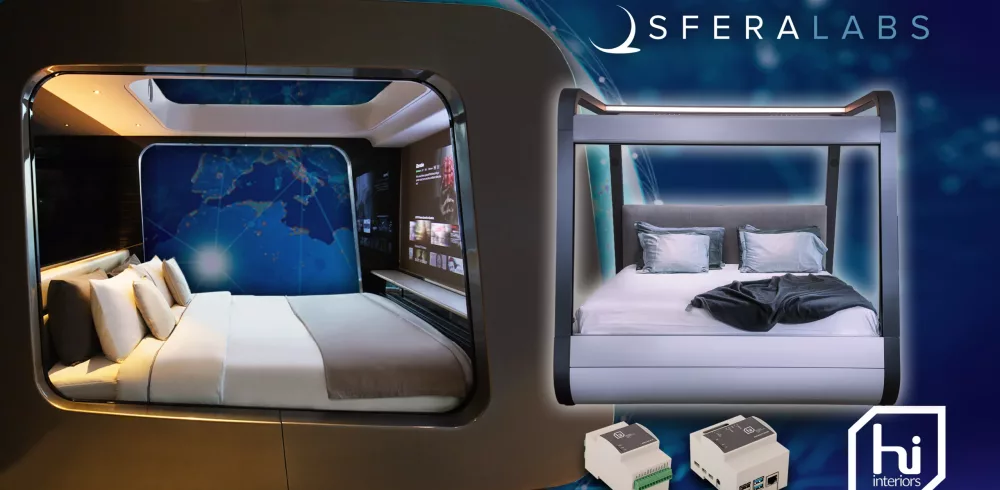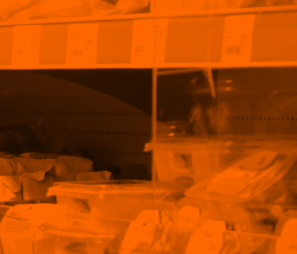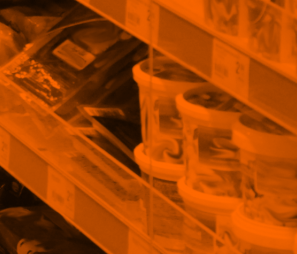The 61st Salone del Mobile fair was held at the Fiera Milano exhibition centre in Milan in April 2023, and attracted more than 300,000 visitors. A notable presence at the fair was Hi-Interiors, showcasing two of its technology-rich hibeds; HiCan and HiAm.
Established in 2008 and based in Milan, Hi-Interiors is credited as accelerating what is being dubbed as the ‘Internet of Furniture’ and although both hibeds have been on the market for a few years, their presence at Salone del Mobile 2023 certainly attracted a crowd.
The company’s HiCan model was launched in 2008 and was revamped in 2017. Hi-Interiors describe the bed as: “A new interpretation of the classic canopy to create an enveloping personal space around you and transform the traditional experience of rest in a moment of higher and authentic well-being.”
HiCan features include (as standard in most cases but as optional extras in others) dimmable reading lights, RGBW ambient lights, adjustable bed bases, a massage module for shoulders and legs, music therapy, a fragrances diffuser, a home theatre audio system, a 4k projector, a 70” motorised screen and support for gaming consoles.
Hi-Interior’s HiAm model, launched in 2022, boasts many of the same features but is more configurable.
Both hibeds can be controlled via a Hi-Interiors app that runs on Apple (IOS) smart phones or via Amazon’s Alexa (i.e., voice controlled). They also monitor a variety of parameters including ambient light levels, air quality, humidity, temperature, background noise levels and even sleep patterns. This last capability is thanks to load cells built into the hibed’s bed nets and the fact that changing weight distribution is indicative of occupant movement. All monitored data can also be accessed via the app.
Clearly, the HiCan and HiAm hibeds are extremely high-tech, and in this case study we will recount how Sfera Labs played a considerable role in the hibeds story.
Bedtime Story
Hi-Interiors initially engaged with Sfera Labs’ sister company HSYCO in 2009. Also based in Milan, HSYCO develops SCADA-based building management system (BMS) software for security, safety and energy management industrial automation systems.
Maria Chizzali, co-founder and COO of both HSYCO and Sfera Labs, recalls: “HSYCO was born out of necessity. We wanted a smart new house, but no integrated graphical user interface existed at the time for controlling commercial automation products.”
Hi-Interiors and HSYCO met through a mutual contact at Logitech. “We were introduced to Ivan Tallarico, the founder of Hi-Interiors and who is from a family of furniture builders,” continues Chizzali. “He had recently graduated from Bocconi University, one of the most prestigious business schools in Italy, and had this idea for a smart bed, but needed help making his idea into reality. Ivan’s idea was then progressed into a design concept by the engineering department of the Università della Calabria (UNICAL).”
Shortly after that introduction, HSYCO began working with Hi-Interiors to progress the concept into a prototype and subsequently engineer the building of the first generation HiCan (see figure 1).
Figure 1 – Above, the first generation HiCan.
The first generation HiCan’s automation system was controlled by a BTicino/Legrand SCS switchboard supervised by HSYCO (the company’s eponymous supervision system). It is a holistic development environment for the integrated control of automation systems offering support for over 100 standard and proprietary protocols.
The supervisor is both technology- and supplier-agnostic and supports the local and remote control of subsystems through a web interface or an App (iOS or Android).
The Revamp
HSYCO’s sister company Sfera Labs was created in 2016. It is a leading designer and manufacturer of advanced solutions for embedded systems and edge computing, specializing in industrial and residential solutions based on open, widely used, and community-supported platforms such as Raspberry Pi and Arduino.
Sfera Labs inherited the relationship with Hi-Interiors and for the second generation HiCan, the following modules were created:
- HiCan Controller – a custom I/O module with digital IO and the ability to drive relays.
- HiCan Exo DMX, an interface to control all lights.
- HiCan Scale – an 8-channel load cell interface.
- HiCan Sense, a temperature, humidity, sound, light and air quality sensors
All modules were based on Sfera Labs’ products and customized for Hi-Interiors. At the heart of the HiCan architecture is a Strato Pi. It includes a Raspberry Pi board and has been enhanced with a variety of hardware features to make it suitable for use in professional and industrial applications where reliability and service continuity are key requirements. Figure 2 shows the above modules and the Strato Pi.
Figure 2 – Left to right: a Strato Pi Base and (branded for Hi-Interiors) a HiCan controller, a HiCan Exo DMX, a HiCan Exo Scale and a HiCan Sense.
“At its core, our Strato Pi is a standard Raspberry Pi,” explains Chizzali, “so no proprietary operating system or proprietary framework is required. This means you can use the same open-source operating system, programming language and development tools for Strato Pi as you would for Raspberry Pi. You can program and run anything, from a simple shell script to a full-fledged Java server in a Docker container.”
The automation control software for the revamped HiCan hibeds was developed using Sfera, the company’s eponymous open-source framework for the development of smart control systems and is written in Java. The bed can also be controlled via an iOS App.
For HiAm, which launched in 2022, it too has a Strato Pi at its heart, plus an Iono RP D16 and a number of customized modules.
Conclusion
Sfera labs played an instrumental role in turning Ivan Tallarico’s vision of a high-tech bed and the Università della Calabria’s early work into HiCan. The company builds and supplies the customised modules in batches to satisfy Hi-Interiors’ production demands, noting that the hibeds are high-end, relatively low-volume products.
However, the relationship between the two companies has not settled into a traditional one of ‘supply-to-order’. Because the hibeds, which cost tens of thousands of dollars, are so customisable (particularly HiAm), every now and then there will a be request for something new. Also, commercial products are changing all the time. Whereas things like screens and projectors might only be expected to have a life of five to 10 years, the hibeds will last longer and upgrading from old to new tech is expected.
“It’s well over 10 years since we identified a market for advanced appliances control, long before IoT came along,” Chizzali concludes. “At the time, automation in the industrial sector was well-established. But it was also a closed, proprietary world. Working with Hi-Interiors, we proved that industrial-grade controllers based on open, community supported technologies could be the ideal tool for implementing commercial goods, networking and automation.”
Manufacturing & Engineering Magazine | The Home of Manufacturing Industry News















